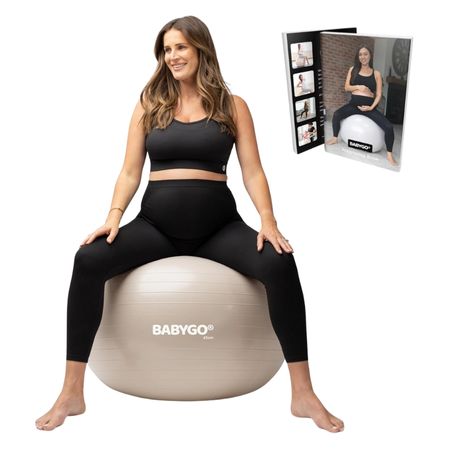
Are you approaching your due date and looking for natural ways to induce labor? Or maybe you’re in early labor and want to encourage optimal positioning for your baby? Look no further than the Miles Circuit! This series of exercises, created by experienced doulas Sharon Muza and Megan Miles, is designed to help get your baby into the optimal position for birth and potentially speed up labor. In this blog post, we’ll dive into what is the Miles Circuit to induce labor, how it works, and how you can use it to help with labor. Plus, we’ll cover some common questions and concerns about the Miles Circuit, so you can feel confident in using this technique. Let’s get started!
Related: Castor Oil To Induce Labor
What Is The Miles Circuit To Induce Labor?
The Miles Circuit is a method aimed at assisting the optimal positioning of the baby, particularly in the Left Occiput Anterior (LOA) position. To learn more about Megan Miles and the circuit itself, you can visit their official website, the Miles Circuit Website. Additionally, they offer a comprehensive handout that can be printed or accessed on your phone, called the Miles Circuit Handout.
Comprising of three steps, the Miles Circuit intends to encourage the baby into a favorable position. The steps are as follows:

Open Knee Chest
To begin, assume a position on all fours, which can be made more comfortable by placing a yoga mat or carpet underneath you. You can even try this position on your bed. From all fours, gradually lower yourself onto your elbows while keeping your buttocks elevated. Adjustments may be needed, and pillows can be used for added comfort. Aim to remain in this position for 10 to 30 minutes. If required, your partner can provide support. Afterward, sit up to a kneeling position for a minute or two, which helps your baby descend into your pelvis and allows you to regain balance.
The purpose of this step is to stretch the ligaments and tissues connected to the uterus, which may be tight due to posture issues, making it challenging for the baby to assume the best position.
Exaggerated Left Side-Lying
For this step, find a comfortable spot in bed with plenty of pillows. Roll onto your left side and extend your right leg out at a 90-degree angle. Place a pillow under your right leg to elevate it above your hip, creating ample space for the baby to move around. The woman is rolled over further to increase room in the pelvis for the baby to shift into the LOA position. Stay in this position for approximately 30 minutes, which can be an opportune time to take a nap.
The purpose of exaggerated side-lying to the left is to encourage the baby to assume the LOA position, with its back facing the mother’s left side. LOA is considered advantageous since it allows the baby to tuck its chin, curve its back, and facilitate easier movement down and out of the pelvis.
Lunges or Curb Walking
Wake up from your nap and put on your shoes, as this step involves physical activity. Step 3 can serve as your daily exercise routine as well. Depending on your weather and location, you have 2 options:
- Curb Walk: Walk near a curb on the street, with one foot on the curb and one foot on the street. It’s recommended to alternate sides to maintain balance.
- Lunge or Stairs Walk: These can be performed indoors and follow a similar concept.
Lunges: Perform lunges while facing sideways.
Stairs Walk: Walk up and down the stairs while facing sideways.
The purpose of lunges or walking sideways on curbs or stairs is to open your pelvis. Walking or lunging in the usual manner tends to narrow the pelvic area, while these exercises stretch the ligaments and muscles, creating more space for the baby.
A note about lunges: The lunges mentioned here are not intense high-intensity interval training (HIIT) lunges. Simply bending your knee until you feel a stretch is sufficient. Additionally, keep in mind that pregnancy hormones loosen ligaments, so it’s important not to overstretch.
Bonus: If you find it challenging to perform the recommended activities, you can sit on a birthing ball and rotate your hips. It is also beneficial to engage in various stretches to open your hips, stretch your thigh and glute muscles, and practice cat-cow poses to relax your abdominal muscles.
It is advised to allocate approximately 30 minutes to each step. However, if this duration proves difficult initially, you can start with 10 minutes and gradually increase it over time.
Related: What Is Stripping Membranes?
When should I start using the Miles Circuit during Pregnancy?
You may start using the Miles Circuit during pregnancy at around 37 weeks. This is typically the recommended time to begin practicing the circuit to encourage the baby into the optimal position for birth. Starting at 37 weeks, you can gradually increase the duration of each position from 10 minutes to eventually reach the full 90 minutes. It is important to note that muscle strength and stamina may not be at their best in late pregnancy, so starting slowly and gradually increasing the time is advised.
Related: What Is Curb Walking To Induce Labor?
How Long After Miles Circuit Did Labor Start?
There is no definitive answer to how long after completing the Miles Circuit labor will start, as it depends on individual circumstances and the readiness of the body and baby for labor. Some women have reported experiencing contractions within a few hours after completing the circuit, while others have not experienced labor until several days later. It’s essential to trust your body and believe in its power to start labor when it’s best for you and the baby.
What are the Benefits of the Miles Circuit during Labor?
The benefits of the Miles Circuit during labor include:
- Helps the baby engage: The Miles Circuit can help move the baby into the optimal position for birth, which can make labor easier and more efficient.
- Speeds up slow or stalled labor: The circuit can help jumpstart labor that has slowed down or stalled.
- Can help with prodromal labor: The Miles Circuit can help with prodromal labor, which is when contractions start and stop without leading to active labor.
- Encourages baby to be in an optimal position: The circuit can help the baby get into the left occiput anterior (LOA) position, which is one of the easiest ways for the baby to move through the birth canal.
- Stretches out your muscles: The Miles Circuit can help stretch out your muscles, which can help you feel more comfortable during labor.
Related: How Does Sex Induce Labor?
Are there any Risks associated with doing the Miles Circuit?
The Miles Circuit is generally considered safe and can be helpful for pregnant women to encourage optimal positioning and potentially speed up labor. However, there are some risks associated with the Miles Circuit that should be considered before starting the circuit.
One of the main risks associated with the Miles Circuit is that it can cause exhaustion, especially if done for an extended period of time. The circuit takes up to 90 minutes to complete, so it’s important to clear your schedule and make mental preparations so you can relax in your environment. It is recommended to start with 10 minutes per position per day, adding a few minutes each day until you get to the full 90 minutes.
Another risk associated with the Miles Circuit is that it can cause discomfort or pain, especially if you have any underlying medical conditions. If you have high blood pressure or some other high-risk diagnosis, it is recommended to speak to your healthcare provider before doing step 3 in particular. Additionally, the positions may feel uncomfortable at first.
Related: VBAC Calculator: Your Key To Success
Are there any modifications to the Miles Circuit for Women with certain Medical Conditions?
Here are the modifications to the Miles Circuit for women with certain medical conditions:
- High blood pressure: If you have high blood pressure or some other high-risk diagnosis, it is recommended to speak to your healthcare provider before doing step 3 in particular which involves curb walking or lunges.
- Underlying medical conditions: The positions may feel uncomfortable or painful if you have any underlying medical conditions. It is recommended to speak to your healthcare provider or doula before starting the circuit if you have any concerns.
Related: How To Stimulate Nipples To Induce Labor?
What about the Baby’s Position during Childbirth?
The significance of the baby’s position during childbirth may not be clear to some mothers. However, it is crucial because an optimal position increases the chances of spontaneous labor and reduces the need for interventions such as forceps delivery, C-sections, and epidurals.
For a vaginal birth, most healthcare providers prefer the baby to be positioned head down. Ideally, the baby’s head should be facing the mother’s back. These positions are referred to as Occiput Anterior (OA) positions. In the head-down position, there are four possible orientations for the baby (source):
- Left Occiput Anterior (LOA): The baby’s head is facing towards the back, with a slight tilt so that the back of the head is positioned towards the mother’s left thigh.
- Right Occiput Anterior (ROA): The baby’s head is facing towards the back, with a slight tilt so that the back of the head is positioned towards the mother’s right thigh.
- Left Occiput Posterior (LOP): The baby’s head is facing outwards, with a slight tilt and looking at the mother’s right thigh.
- Right Occiput Posterior (ROP): The baby’s head is facing towards the back, with a slight tilt and looking at the mother’s left thigh.
It’s important to note that OA positions are more favorable than Occiput Posterior (OP) positions, also known as “Sunnyside up.” Occiput Posterior positions can be associated with back labor, higher rates of interventions, and more challenging vaginal births.
Related: Create Your Birth Plan – Checklist for Parents
Can it help turn a Breech Baby?
While it is a great tool to encourage optimal positioning, it is important to note that the Miles Circuit is not specifically designed to flip a breech baby. However, there are other techniques that may be more effective for turning a breech baby, such as the Forward-leaning Inversion and brisk walking for a mile or more every day for three days.
Related: How do Celebrities avoid Stretch Marks during Pregnancy?
What are the Pros and Cons of Miles Curcuit?
Pros
- Encourages optimal positioning for the baby
- Can help speed up slow or stalled labor
- Can help with prodromal labor
- Stretches out your muscles
- Can be done daily starting around 37 weeks
Cons
- May cause exhaustion if done for an extended period of time
- May cause discomfort or pain, especially if you have underlying medical conditions
- May not be suitable for women with high blood pressure or other high-risk diagnoses
- No definitive research to suggest that it can start labor
Download – Miles Circuit Handout For Free
Induce Labor Naturally with This Birthing Ball

Conclusion
The Miles Circuit is a natural method that can aid in labor progression by optimizing fetal positioning and creating an ideal birthing environment. By incorporating the Open Knee Chest, Exaggerated Left Side-Lying, and Lunges or Curb Walking positions, expectant mothers can potentially enhance the progress of labor and experience a more comfortable birthing process. However, it is essential to consult with your healthcare provider or a qualified birth professional to ensure the Miles Circuit is suitable for your specific circumstances. Remember, every pregnancy and labor experience is unique, and personalized guidance is crucial to ensure the safety and well-being of both the mother and baby.
Related: True Stories of Pregnancy after Tubal Ligation
Frequently Asked Questions (FAQs)
Can the Miles Circuit be performed during pregnancy?
Yes, the Miles Circuit can be performed during pregnancy. It can help promote optimal fetal positioning and prepare the body for labor. However, it is advisable to consult with your healthcare provider or a qualified birth professional before starting any new exercise regimen.
How long should each position of the Miles Circuit be held?
The duration of each position in the Miles Circuit can vary. It is recommended to spend around 10-15 minutes in each position. However, it is essential to listen to your body and adjust the time accordingly.
Is the Miles Circuit suitable for all pregnancies?
The Miles Circuit is generally considered safe and suitable for most pregnancies. However, it is crucial to consult with your healthcare provider, especially if you have any specific medical conditions or complications that may require personalized advice.
Can the Miles Circuit guarantee the onset of labor?
While the Miles Circuit can help create optimal conditions for labor, it does not guarantee the immediate onset of labor. It is essential to remember that each pregnancy is unique, and labor onset can be influenced by various factors.
When should I start practicing the Miles Circuit?
You can start incorporating the Miles Circuit exercises and positions into your routine during the third trimester of pregnancy. However, it is always recommended to consult with your healthcare provider before beginning any new exercise program.
Are there any risks associated with the Miles Circuit?
The Miles Circuit is generally considered safe, but it is crucial to perform the exercises and positions correctly and listen to your body. If you experience any unusual pain, discomfort, or complications, it is advisable to consult with your healthcare provider.












